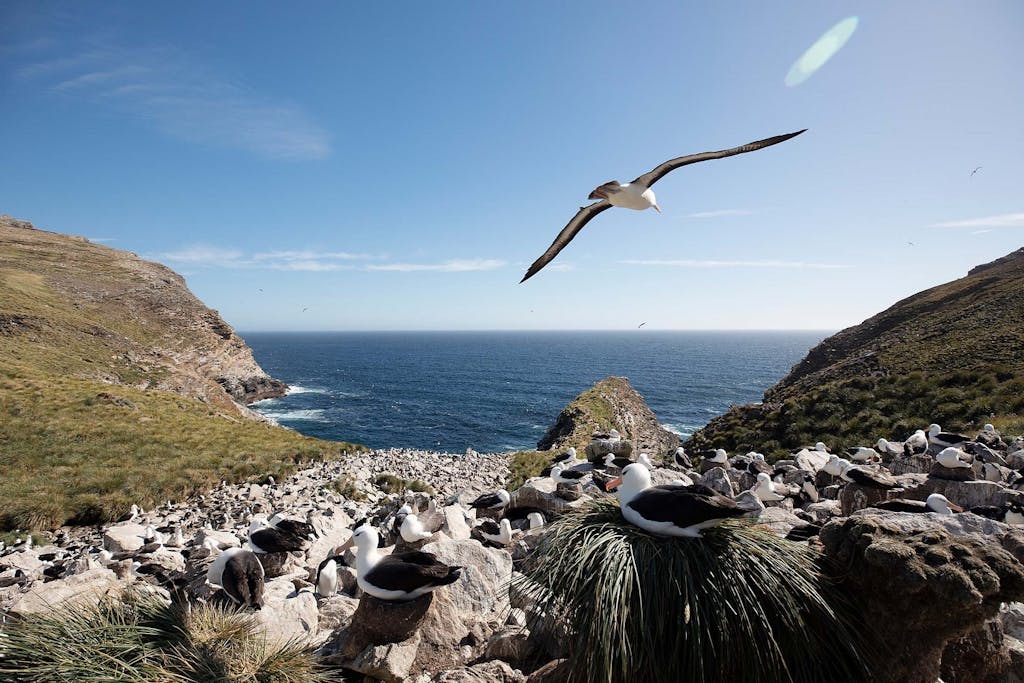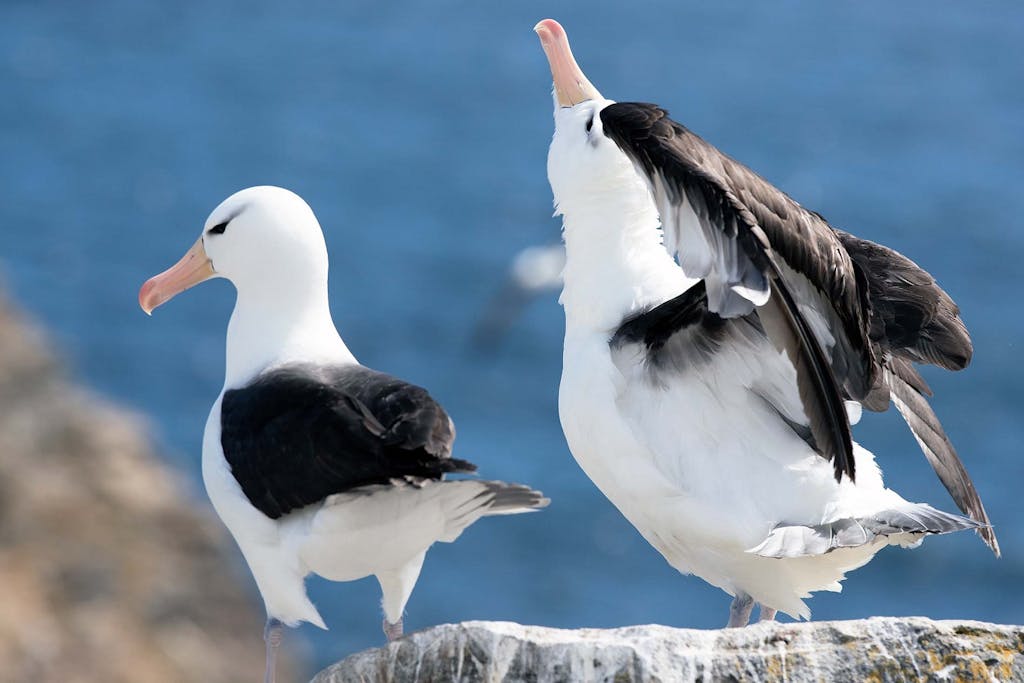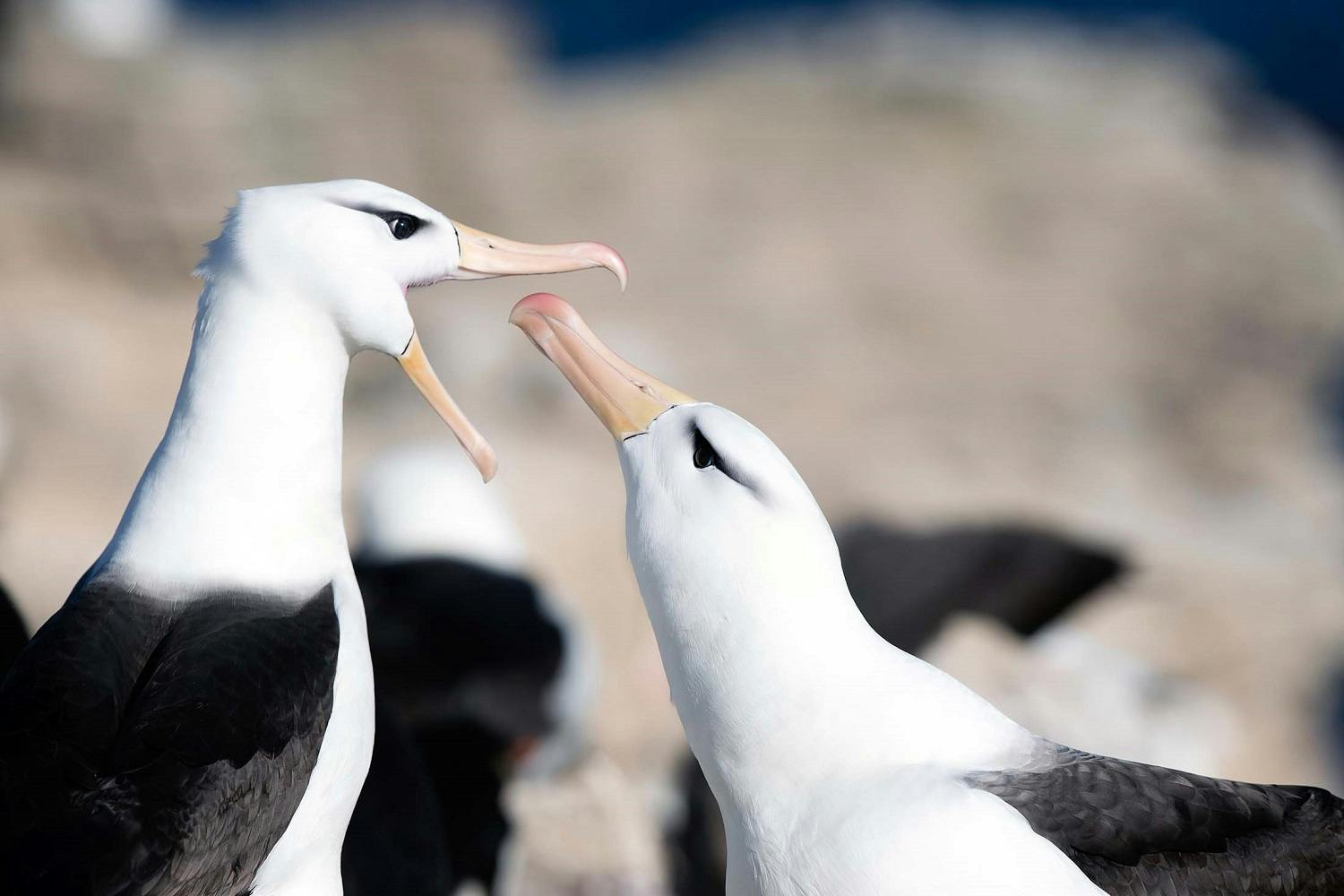Discovering the Albatrosses of West Point Island, Once Known as Albatross Island
Watching a black-browed albatross soar over the ocean is an unforgettable experience. Whether sweeping smoothly just above the sea’s surface or gliding high across the sky with ocean breezes beneath their long wings, these magnificent seabirds have fascinated writers and seafarers through the ages.
Because these birds spend most of their lives at sea, most people don’t get a chance to see them — unless, perhaps, they visit islands like the place once known as Albatross Island. In “Moby Dick,” Herman Melville — who spent more than a year working on a whaling ship during the 1840s — describes his sighting of a “regal, feathery thing” and admires the “vast archangel wings” of the albatross. The most famous appearance of the bird is its starring role in “The Rime of the Ancient Mariner,” the 1798 poem by Samuel Taylor Coleridge. Despite the poet’s lyrical descriptions, Coleridge himself never actually saw an albatross.

Black-browed albatross couples mate for life
Your best chance to see an albatross up close is when they gather in large colonies to breed. “More than two-thirds of the world’s albatross population breeds on the Falkland Islands in South America,” says former Silversea ornithologist Chris Harbard, adding that the total breeding population of black-browed albatrosses is about 602,000 pairs. Harbard accompanies Silversea’s expedition cruises to the Falkland Islands, where thousands of albatross breeding pairs and their chicks nest among clumps of the native tussac grass. “In destinations like Saunders Island, for example, we can be within two meters of the albatross — it’s a breathtaking Attenborough moment!” he says.
“One of the most endearing things about the albatross is that they mate for life. And, for them, a lifetime can be 60 years or more,” says Harbard. Albatrosses start to breed when they are around 10 years old. Younger birds return to the colony before breeding age, learning to court and practicing their dance steps — but they don’t form a pair bond until they are older. When an albatross first chooses its breeding partner, it goes through intricate courting dances, fanning its tail in a display. Black-browed albatrosses then pair up during the eight-month breeding season each year at their colony.

Tracking their yearly sabbatical
These Falkland Islands birds like their space. Once breeding is over, they return to their solitary adventures at sea, with males and females typically feeding in different areas. Not all birds breed annually; some wait another year before they reproduce again.
After the breeding season, Harbard says that birds have been tracked up to 3,000 kilometers from their breeding locations. But being so far from land is no problem for the albatross: They can sleep while they fly. “They are able to shut down half of the brain while continuing with the other half,” Harbard explains. “They also sleep sitting on the water.” One juvenile tristan albatross was tracked traveling nearly 500 kilometers each day during 2015, racking up 186,684 kilometers (116,000 miles) over 383 days.
Like all good long-term couples, albatrosses spend time working on their relationships. “The birds strengthen their pair bond throughout the time they spend together,” Harbard confirms — adding that these sights are a delight to behold. “When a bird returns to the nest site to relieve the other of its parental duties, there are always ritual displays of greeting that help to keep the pair bond strong.”
The most common is mutual preening, also called allopreening, where the birds preen each other simultaneously on the head and neck. There are also some touching public displays of affection when birds reunite after an absence. “Birds point their bills at one another, often touching their bills together,” he explains. “There is also calling by one bird to another, with its beak wide open.”

Raising the albatross chicks
Albatross parents work together to build a mound nest on the ground, protected by the surrounding tussac grass and near a slope for easy access to air currents. They cackle and bray to mark their territory, and lay just one egg, which takes two to three months to hatch. Both parents incubate the single egg and feed the young chick, leaving it when it is large enough so both can feed, mainly on fish, squid and krill, which they catch by shallow diving from the water’s surface.
“While one bird is at the nest, its partner may be away feeding for one or two weeks and may travel hundreds of kilometers from the colony to find food,” Harbard explains. Parents find their chicks by voice and smell, he adds, so breeding colonies are quite noisy places. When eggs hatch, albatross chicks resemble little gray balls of fluff, and their tiny hooked beaks start out black.
“The parents feed their chicks by regurgitation, trickling an oily liquid from their upper stomach into the chick’s open beak,” Harbard says. “The chick will peck at the beak of its parent from below to stimulate it to regurgitate food.” Chicks are then ready to fledge in around four months, and large youngsters look somewhat ludicrous as they approach independence, weighing up to 50 percent more than their parents. That extra energy store helps them as their feathers grow and they learn to feed themselves.

When it’s time to launch, youngsters will begin to open and flap their wings at the nest. Then, once winds reach around 20 kilometers per hour, the young albatross can lift off and fly out to sea, where it learns to forage and feed on its own.
Sadly, more than half of young albatross do not survive their first year, with most dying during winter, snatched by opportunistic birds or malnourished due to a scarcity of food. Commercial longline fishing is the biggest threat to older albatrosses, and plastic ingestion is also a huge problem.
But the hardy albatrosses that survive those critical early days will return year after year to their birthplace — many living and continuing to breed for decades. Between breeding seasons, the spectacular sight of a lone albatross on the wing continues to inspire seafarers around the world.

Want to see magnificent birds like the ones found on Albatross Island? Check out Silversea’s expedition cruises to South America and learn more about the albatrosses and penguins of Saunders Island.
